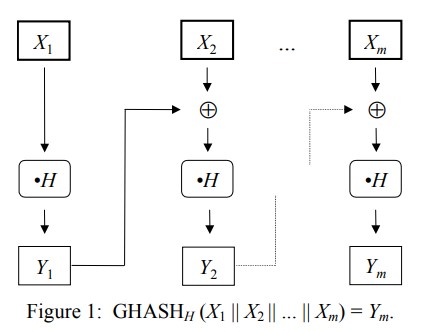一、GCM介绍
GCM 是分组密码的一种工作模式,具体细节可通过 NIST 的文档了解
Recommendation for Block Cipher Modes of Operation: Galois/Counter Mode (GCM) and GMAC
二、GHash查表优化
查表优化的思想就是利用预处理生成查找表,在正式运算时利用查表节约操作开销,该优化方案在 OpenSSL 和 Oryx Embedded 这两个密码库中都有采用。
优化算法论文为 D. McGrew and J. Viega 的 The Galois/Counter Mode of Operation (GCM)
2.1 GHash模块

GHash 模块的结构与 CFB 模式类似,记每一轮输入为 Xi,输出为 Yi。那么
Yi=(Yi−1⊕Xi)⋅H
其中 Y1=X1⋅H,乘法为 GF(2128) 有限域乘法,Xi 长度为 128bit
合并后表达式如下
Ym=GHashH(X1|X2|⋯|Xm)=((((X1⋅H)⊕X2)⋅H)⊕⋯⊕Xm)⋅H
2.2 GF(2128) 有限域乘法 gmul 模块
GF(2128) 中使用的不可约多项式为 p(x)=1+x+x2+x7+x128
对于一个比特串 b0b1⋯b127,其对应的多项式为 b0+b1x+b127x127。例如,不可约多项式 p(x) 对应的比特串为 E1|(0⋯0)120,E1=11100001
2.3 有限域乘法查表优化
将表达式 X⋅H 进一步展开成 X=b0+b1x8+⋯+b15x120,有
X⋅H=(b0H)+(b1H)⋅x8+⋯+(b15H)⋅x120=((b15H⋅x8+b14H)⋅x8⋯)⋅x8+b0H
其中 bi 是 8 比特数,故可预先生成查找表 HTable(a)=a⋅H,a∈[0,255],将 bi⋅H 转化为查表操作
查找表可以通过如下公式递推生成,记 a=a0+a1x+⋯a7x7
- HTable(0)=0,HTable(1)=H
- 若 a0=0,那么 HTable(a)=x⋅HTable(a / x)
- 若 a0=1,那么 HTable(a)=H⊕HTable(a - 1)
此外,对于 x8 乘法等价于直接移位,将会溢出 8 比特数据位,这部分也通过预先生成的查找表 ReduceTable(a)=a⋅x128≡a⋅(1+x+x2+x7)modp,利用查表完成模操作
注:除了像上述以 8 比特为单位外,还可以 4 比特为单位。虽然速率有所降低,但所需要的查找表大小大幅减小。
三、代码实现
GCM的代码我已经开源至我自己写的密码库GMLib中,下面截取其中的有限域乘法gmul模块
3.1 功能函数
首先是大端读入与存储的功能函数
3.2 gmul 普通实现
NIST 文档 p13-14 页已经给出 gmul 的伪代码,通过该伪代码可以得到 gmul 的普通实现
3.3 gmul 查表优化实现
查表初始化操作的 a 递推顺序为 1000 0000, 0100 0000, 1100 0000, ..., 1111 1111。为了解决递推索引顺序与 a 的差异,定义比特翻转的查找表,即 Rev(b0b1⋯b7)=b7⋯b0。当索引 i 从 1 递增到 255 时,对应的 a=Rev(i) 则从 1000 0000 递增到 1111 1111
static int Rev[256] = {
0, 128, 64, 192, 32, 160, 96, 224, 16, 144, 80, 208, 48, 176, 112, 240,
8, 136, 72, 200, 40, 168, 104, 232, 24, 152, 88, 216, 56, 184, 120, 248,
4, 132, 68, 196, 36, 164, 100, 228, 20, 148, 84, 212, 52, 180, 116, 244,
12, 140, 76, 204, 44, 172, 108, 236, 28, 156, 92, 220, 60, 188, 124, 252,
2, 130, 66, 194, 34, 162, 98, 226, 18, 146, 82, 210, 50, 178, 114, 242,
10, 138, 74, 202, 42, 170, 106, 234, 26, 154, 90, 218, 58, 186, 122, 250,
6, 134, 70, 198, 38, 166, 102, 230, 22, 150, 86, 214, 54, 182, 118, 246,
14, 142, 78, 206, 46, 174, 110, 238, 30, 158, 94, 222, 62, 190, 126, 254,
1, 129, 65, 193, 33, 161, 97, 225, 17, 145, 81, 209, 49, 177, 113, 241,
9, 137, 73, 201, 41, 169, 105, 233, 25, 153, 89, 217, 57, 185, 121, 249,
5, 133, 69, 197, 37, 165, 101, 229, 21, 149, 85, 213, 53, 181, 117, 245,
13, 141, 77, 205, 45, 173, 109, 237, 29, 157, 93, 221, 61, 189, 125, 253,
3, 131, 67, 195, 35, 163, 99, 227, 19, 147, 83, 211, 51, 179, 115, 243,
11, 139, 75, 203, 43, 171, 107, 235, 27, 155, 91, 219, 59, 187, 123, 251,
7, 135, 71, 199, 39, 167, 103, 231, 23, 151, 87, 215, 55, 183, 119, 247,
15, 143, 79, 207, 47, 175, 111, 239, 31, 159, 95, 223, 63, 191, 127, 255,
};
查表表定义和初始化操作,将查找表 HTable 定义为二维数组,第一维是 a 的索引,第二维分别存储 HTable[a] 的高 64 位和低 64 位
定义 ReduceTable
static uint16_t ReduceTable[256] = {
0x0000, 0x01c2, 0x0384, 0x0246, 0x0708, 0x06ca, 0x048c, 0x054e, 0x0e10,
0x0fd2, 0x0d94, 0x0c56, 0x0918, 0x08da, 0x0a9c, 0x0b5e, 0x1c20, 0x1de2,
0x1fa4, 0x1e66, 0x1b28, 0x1aea, 0x18ac, 0x196e, 0x1230, 0x13f2, 0x11b4,
0x1076, 0x1538, 0x14fa, 0x16bc, 0x177e, 0x3840, 0x3982, 0x3bc4, 0x3a06,
0x3f48, 0x3e8a, 0x3ccc, 0x3d0e, 0x3650, 0x3792, 0x35d4, 0x3416, 0x3158,
0x309a, 0x32dc, 0x331e, 0x2460, 0x25a2, 0x27e4, 0x2626, 0x2368, 0x22aa,
0x20ec, 0x212e, 0x2a70, 0x2bb2, 0x29f4, 0x2836, 0x2d78, 0x2cba, 0x2efc,
0x2f3e, 0x7080, 0x7142, 0x7304, 0x72c6, 0x7788, 0x764a, 0x740c, 0x75ce,
0x7e90, 0x7f52, 0x7d14, 0x7cd6, 0x7998, 0x785a, 0x7a1c, 0x7bde, 0x6ca0,
0x6d62, 0x6f24, 0x6ee6, 0x6ba8, 0x6a6a, 0x682c, 0x69ee, 0x62b0, 0x6372,
0x6134, 0x60f6, 0x65b8, 0x647a, 0x663c, 0x67fe, 0x48c0, 0x4902, 0x4b44,
0x4a86, 0x4fc8, 0x4e0a, 0x4c4c, 0x4d8e, 0x46d0, 0x4712, 0x4554, 0x4496,
0x41d8, 0x401a, 0x425c, 0x439e, 0x54e0, 0x5522, 0x5764, 0x56a6, 0x53e8,
0x522a, 0x506c, 0x51ae, 0x5af0, 0x5b32, 0x5974, 0x58b6, 0x5df8, 0x5c3a,
0x5e7c, 0x5fbe, 0xe100, 0xe0c2, 0xe284, 0xe346, 0xe608, 0xe7ca, 0xe58c,
0xe44e, 0xef10, 0xeed2, 0xec94, 0xed56, 0xe818, 0xe9da, 0xeb9c, 0xea5e,
0xfd20, 0xfce2, 0xfea4, 0xff66, 0xfa28, 0xfbea, 0xf9ac, 0xf86e, 0xf330,
0xf2f2, 0xf0b4, 0xf176, 0xf438, 0xf5fa, 0xf7bc, 0xf67e, 0xd940, 0xd882,
0xdac4, 0xdb06, 0xde48, 0xdf8a, 0xddcc, 0xdc0e, 0xd750, 0xd692, 0xd4d4,
0xd516, 0xd058, 0xd19a, 0xd3dc, 0xd21e, 0xc560, 0xc4a2, 0xc6e4, 0xc726,
0xc268, 0xc3aa, 0xc1ec, 0xc02e, 0xcb70, 0xcab2, 0xc8f4, 0xc936, 0xcc78,
0xcdba, 0xcffc, 0xce3e, 0x9180, 0x9042, 0x9204, 0x93c6, 0x9688, 0x974a,
0x950c, 0x94ce, 0x9f90, 0x9e52, 0x9c14, 0x9dd6, 0x9898, 0x995a, 0x9b1c,
0x9ade, 0x8da0, 0x8c62, 0x8e24, 0x8fe6, 0x8aa8, 0x8b6a, 0x892c, 0x88ee,
0x83b0, 0x8272, 0x8034, 0x81f6, 0x84b8, 0x857a, 0x873c, 0x86fe, 0xa9c0,
0xa802, 0xaa44, 0xab86, 0xaec8, 0xaf0a, 0xad4c, 0xac8e, 0xa7d0, 0xa612,
0xa454, 0xa596, 0xa0d8, 0xa11a, 0xa35c, 0xa29e, 0xb5e0, 0xb422, 0xb664,
0xb7a6, 0xb2e8, 0xb32a, 0xb16c, 0xb0ae, 0xbbf0, 0xba32, 0xb874, 0xb9b6,
0xbcf8, 0xbd3a, 0xbf7c, 0xbebe,
};
使用上文提及的公式,利用查找表完成 gmul 操作
3.4 调用样例
参考资料:D. McGrew and J. Viega. The Galois/Counter Mode of Operation (GCM)
__EOF__






【推荐】国内首个AI IDE,深度理解中文开发场景,立即下载体验Trae
【推荐】编程新体验,更懂你的AI,立即体验豆包MarsCode编程助手
【推荐】抖音旗下AI助手豆包,你的智能百科全书,全免费不限次数
【推荐】轻量又高性能的 SSH 工具 IShell:AI 加持,快人一步
· 无需6万激活码!GitHub神秘组织3小时极速复刻Manus,手把手教你使用OpenManus搭建本
· C#/.NET/.NET Core优秀项目和框架2025年2月简报
· 葡萄城 AI 搜索升级:DeepSeek 加持,客户体验更智能
· 什么是nginx的强缓存和协商缓存
· 一文读懂知识蒸馏